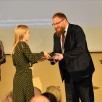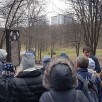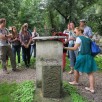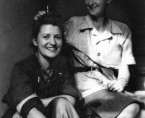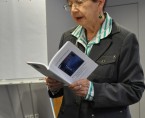Volunteers of the Memorial honoured with the awards “If Not for Those Ten... ”
Seminar in collaboration with the academic centre for oral history in Voronezh
International Summer Academy 2019 in English and German - Call for Participants
Educational challenges in authentic memorial sites
Thematic sessions
A Different Approach to September 1939
The session was organized on the anniversary of the outbreak of WWII.
Its participants – teachers and tour guides – were made acquainted with the following scientific lectures: “Wehrmacht Crimes in Poland in 1939”, “Einsatzgruppen and Selbstschutz in a Fight Against the Polish Nation”, “Poland Between Two Aggressors – September 1 and 17, 1939”, as well as watched a selection of documentary films devoted to the outbreak of WWII.
A Volunteer to Auschwitz
The session was prepared for teachers and school youth on the 60th anniversary of the death of Witold Pilecki, captain of the Polish Army, a Home Army soldier, a prisoner and organizer of resistance movement in Auschwitz-Birkenau.
After the war, Pilecki was charged and sentenced by the communist authorities of the People’s Republic of Poland to death and executed in 1948. In the course of the session, the participants became acquainted with the biography of Witold Pilecki and participated in a meeting with the former prisoner of Auschwitz – Tadeusz Sobolewicz. Moreover, they watched a documentary film devoted to the escape of Pilecki, participated in ceremonious remembrance of Pilecki, as well as visited an exhibition devoted to him. Young people also got to know the biographies of other prisoners of KL Auschwitz who, after the war, were repressed by the Security Office (UB).
Apogee of Crime. Extermination of Jews from Hungary
Hungarian Jews were the largest group among Jews deported to Auschwitz. From the end of April to August 1944, approx. 430,000 men, women and children were brought to Auschwitz – an educational session in 2004 was devoted to them.
Participants of the session listened to a lecture (“Situation of Hungarian Jews on the Eve of Deportation to KL Auschwitz”) and took part in a lecture in the Archives (“Fate of Jews from Hungary in KL Auschwitz in the Light of the Preserved Archival Documents”) and in workshops (“An Album from Auschwitz – History of One Transport”, “Lost Fate – Literary Evidence of the Holocaust of Jews from Hungary”).
Art Works of Auschwitz Prisoners
An educational session devoted to works of art created by Auschwitz prisoners.
The participants listened to a lecture of Joanna Kupiec, author of the following albums: “Auschwitz in Sculpture” (Auschwitz w rzeźbie), “End of the Tether” (U kresu sił) and “What will Last from Us…?” (Cóż po nas pozostanie…?”) and participated in methodological workshops on the use of albums about art created in the camp when working with pupils.
Borowski’s Auschwitz: Literature and Film
The session begun with a lecture devoted to the biography and artistic work of Tadeusz Borowski.
Subsequently, the participants became acquainted with adaptations of Borowski in films and watched a documentary film entitled “Testament".
Camp Orchestras in KL Auschwitz
An educational session for teachers, tour guides and young people from high schools devoted to the issue of orchestras which used to exist in Auschwitz.
The session began with a lecture devoted to the music created in concentration camps and works of composers who died in camps. Subsequently, a meeting with Helena Niwińska, a former Auschwitz prisoner, took place. She was a member of the women’s camp orchestra in Birkenau. There was also a lecture devoted to the history of orchestras in Auschwitz. The participants watched films devoted to the topic: “The Oświęcim Band”[Kapela oświęcimska] and “From the Auschwitz Chronicle.” The session was combined with a concert of Ensemble Voix Etouffees, which commemorates the works of composers who were camp prisoners or who died in camps.
Children in KL Auschwitz
The session, intended for teachers and graduates of training sessions that were conducted by the Centre for Education, referred to the children living in the camp. The following lectures formed its part: “The Youngest Prisoners in KL Auschwitz”, “Criminal Activity of Doctor Mengele” and workshops “Fate of Children in Auschwitz on the Basis of Documents and Accounts of Former Prisoners.” On the basis of partially preserved camp documents and estimated data, it was determined that among the people deported to Auschwitz-Birkenau, there were approx. 232,000 children and young people below 18.
Children of the Holocaust Speak
An educational session for pupils and teachers from high schools. The subject was related to war and post-war fates of children saved from the Holocaust, as well as stances of the Polish community with respect to the Holocaust.
During the session, the participants met with people saved from the Holocaust: Krystyna Budnicka, Anna Drabik, Elżbieta Ficowska and Joanna Sobolewska-Pyz – members of the Association Children of the Holocaust in Poland. Apart from a series of documentary films (“Requiem for 500,000”[Requiem dla 500 tysięcy], “Children of Cloisters”[Dzieci klasztorów], “Memories from the Ghetto”[Wspomnienia z getta]), the session participants had an opportunity of watching a staging of a performance entitled “Children of the Holocaust Speak” prepared by pupils of the PZS High School in Kęty.
SS Personnel in KL Auschwitz
During a session devoted to SS-men in Auschwitz, the participants listened to lectures about every-day life of SS-men in KL Auschwitz and a comparative analysis of SS-men and functional prisoners, presenting two manners of supervision over prisoners.
They also became acquainted with the issue of female SS supervisors in the women’s camp, as well as watched a multimedia presentation showing the artifacts related to the SS-personnel stored in the Research Department of the PMA-B.
Theresienstadt. From the Ghetto to the Family Camp in Birkenau
On September 8, 1943 in the area of Birkenau (BIIb sector), a family camp was established for Jews, where approx. 18,000 Jews from the Terezin ghetto were placed between 1943 and 1944.
The educational session in 2004 was devoted to the fates of these prisoners. During the session, the participants listened to the lectures: “Role of the Terezin Ghetto in the Nazi Policy of Exterminating Czech and German Jews,” “The Terezin Family Camp in Accounts and Archival Documents” and participated in workshops: “Prisoners from Bohemia in KL Auschwitz,” “Art in the Face of Death – in Remembrance of the Terezin Children.”
Voices of Memory
An educational session devoted to publications from the “Voices of Memory” series: “Evacuation, Liquidation and Liberation of KL Auschwitz”, “Criminal medicine. Medical Experiments in KL Auschwitz” and “Criminal Medicine. Hospitals in KL Auschwitz.”
Warsaw Uprising from the Perspective of Auschwitz
The last large group of Poles brought to KL Auschwitz were inhabitants of Warsaw who – in the number of 13,000 (men, women and children) — were brought in August and September 1944.
Their deportation took place in relation to the uprising in Warsaw against the occupant and the decision of the German authorities on removal of the surviving civil population from Warsaw and destruction of the city. The fate of the inhabitants of Warsaw who were brought to Auschwitz in relation to the uprising was the subject of an educational session. It was commenced by lectures and a discussion devoted to the controversies of the Warsaw uprising and the exodus of civil population from the Warsaw Uprising. Subsequently, the participants met with witnesses of the events: Marka Kosk, Maria Stroińska, Elżbieta Sobczyńska, Kazimierz Kozłowski and Jerzy Maria Ulatowski.
Words Enclosed in a Drawing
An educational session for teachers and pupils organized due to the opening of an exhibition of art works of Marian Kołodziej, a former Auschwitz prisoner.
The participants became acquainted with the issue of artistic creativity in KL Auschwitz, met with the artist – Marian Kołodziej, as well as saw the exhibition of his works. Marian Kołodziej, an artist and outstanding Polish set designer, was prisoner No. 432 in Auschwitz from the first day of its existence to the very end. During the existence of the camp, the artist created works describing the fate of prisoners. In the middle of 1990s, he also created “Plates of Memory” a cycle of drawings – labyrinths of memories. A collection of works from the 1990s is in Centre of Father Kolbe in Harmęże, the place of the former sub-camp, whereas art works from the period of operation of the camp are stored in the Collections Departments of the State Museum Auschwitz-Birkenau. Marian Kołodziej died in 2009.
“The Atrocious Crime.” Sonderkommando Rebellion
On October 7, 1944, the greatest rebellion and escape attempt took place in KL Auschwitz, organized by Jews from Sonderkommando.
They set on fire and gravely damaged one crematorium and attacked SS-men who were near it. Some managed to cut open the wires and escape from the camp. Unfortunately, during the pursuit, all the escapees were surrounded by SS-men and murdered. In total, approx. 250 Jews died in the fight. As repression, the camp authorities murdered 200 prisoners from Sonderkommando. On the 60th anniversary of these events, the Centre for Education organized a didactic session which begun with a popular science lecture entitled “Sonderkommando Functions in KL Auschwitz. Rebellion of October 7, 1944.” Subsequently, a presentation in the Archive was held (“Preparations, Course and Consequences of Sonderkommando Rebellion in the Light of Preserved Archival Documents”), meeting with a witness of these events, Henryk Mandelbaum and a meeting with the author of a book about Sonderkommando “... We Wept Without Tears” Gideon Greif.
Conspirers: Polish Women in the Resistance Movement 1939-1945
A session about women in the resistance movement. It encompassed a lecture entitled “Soldiers of the Home Army in KL Auschwitz-Birkenau”.
After the lecture, a film entitled “Conspirers: Polish Women in the Resistance Movement 1939 – 1945” was shown. There was also a meeting with the director of the film, Paul Meyer.
Episodes from Auschwitz. Stories told with Drawings
An educational session was devoted to two comic books: “Love in the Shadow of the Holocaust” and “Witold’s Report” which were published in the “Episodes from Auschwitz” series.
A lecture, “Volunteer to Auschwitz. Captain Witold Pilecki (1901 – 1948),” was presented during the session. There was also a workshop devoted to the use of comic books in historical education and a meeting with a set designer who shared his knowledge about making historical comic books and publishers who talked about the idea and the premises of the comic book.
Escapes from KL Auschwitz
At the beginning, the participants took part in a series of short lectures: “Fences and Escape Prevention System in KL Auschwitz,” “Escapes from KL Auschwitz,” and “Reports of Escapees.”
Then they watched a film entitled “Man on the Run” recounting a story of escape of some prisoners, including Kazimierz Piechowski, who is the main character in the film. At the end of the session, young people and their teachers participated in a meeting with August Kowalczyk, a former Auschwitz prisoner who escaped from the camp. The meeting was combined with a visit to places where Mr. Kowalczyk was hiding during his escape.
Fairy Tales from Auschwitz
During the session, a lecture introducing to the fairy tales created in Auschwitz took place.
The participants met with the author of the film entitled “Fairy Tales from the Land of Furnaces”[Bajki z krainy pieców] by Andrzej B. Czulda, and participated in workshops devoted to the fate of children in the ghetto, as well as became acquainted with the characteristics of museum collections related to the children in Auschwitz among which there is a copy of fairy tales written in Auschwitz
Fate of Sinti and Roma in KL Auschwitz
On February 26, 1943, in Auschwitz-Birkenau, at the BIIe section, a Gypsy family camp was established, called Zigeunerlager, which existed for 17 months.
On the 60th anniversary of its establishment, the Centre for Education organized a thematic session for teachers and Museum tour guides. During the session, there were lectures (“What Does it Mean to be a Gypsy, that is the Roma Identity”, “Roma under the government of the 3rd Reich”, “Modern Problems of the Roma Community”) and workshops (“Extermination of Sinti and Roma in KL Auschwitz on the Basis of Documents, Accounts of Former Prisoners and Exhibition in block No. 13”).
It is estimated that approx. 23,000 Roma were imprisoned in the camp – men, women and children. Approx. 21,000 were registered in the camp (including children who were born here; their number probably exceeded 370). A group of approx. 1,700 Polish Roma was murdered in a gas chamber immediately after arrival in the camp, without being registered in the camp records.
Fate of Women in KL Auschwitz
A session devoted to the existence of women in Auschwitz.
During the session, the participants listened to lectures: “Women in KL Auschwitz”, “Women Prisoners in the Camp Orchestra” and took part in a meeting with witnesses of history.
First Poles in KL Auschwitz
The programme of the session about first Poles in Auschwitz.
Program included the following lectures: “First transports of Polish Political Prisoners in KL Auschwitz”, “Role of Poles, Former KL Auschwitz Prisoners in the Preservation of Memory about the Camp Reality vs. the Educational Activities of the State Museum Auschwitz-Birkenau,” as well as a panel discussion attended by former prisoners.
For the Righteous
An educational session devoted to Henryk Sławik who saved approx. five thousand Polish Jews during WWII. He paid the highest price for his devotion – in 1944 he was murdered in Mauthausen by the Nazi.
The session was commenced by a lecture given by Grzegorz Łubczyk, the author of a book about Henryk Sławik, devoted on the biography of the Polish Righteous. Subsequently, other people awarded with the title Righteous Among the Nations of the World from Poland were discussed. The participants watched a film entitled “Righteous Among the Nations of the World.”
Jews in Oświęcim
Jewish inhabitants in Oświęcim before WWII constituted approx. 60% of the town’s population.
During WWII, the Jews from Oświęcim were placed in ghettos in Chrzanów, Będzin and Sosnowiec from where, after their liquidation, they were sent to the Auschwitz-Birkenau concentration camp. After the war, few Jews who survived returned to Oświęcim. In 1946, 186 Jews lived here. By 1955, probably all of them emigrated. The pre-war fate of Jews was the subject of an educational session entitled “Jews in Oświęcim.” The participants of the session took part in workshops entitled “Following the Traces of Oświęcim Jews” and then became acquainted with the history of Jewish inhabitants of Oświęcim from the beginnings of settlement in the town until 1867.
Lost Families
An educational session for teachers and tour guides devoted to families who died in KL Auschwitz.
It consists of a lecture and a workshop. During the lecture, the participants became acquainted with fates of Jewish families from Będzin (“Between the Holocaust and Salvation. Fate of an Average Jewish Family in Będzin in the Occupation Period”), the fate of families from the Łódź ghetto and Auschwitz (“Fate of Jewish Families in the Light of Documents Regarding the Łódź Ghetto and KL Auschwitz”) and learnt about Freddy Hirsh – a teacher of young people who died in Auschwitz. The workshops were devoted to Jewish families from Terezin who died in Auschwitz (“Art in the Face of Death – In Memory of the Teresienstadt Families”) and classes devoted to the presentation of didactic materials for working with young people.
Medicine in KL Auschwitz
An educational session entitled “Medicine in KL Auschwitz” was devoted to medical experiments in KL Auschwitz.
It was commenced with an introductory lecture “Medicine of the 3rd Reich.” Subsequently, the session participants listened to lectures devoted to medical experiments conducted in KL Auschwitz and the hospital in KL Auschwitz, as well as participated in workshops devoted to experimental block No. 10.
Memories “From There”
An educational session devoted to the works of the Israeli poet Batszewa Dagan, a former Auschwitz prisoner.
Participants of the meeting – teachers, young people and the Museum tour guides – listened to Batszewa Dagan’s lecture about teaching children about the Holocaust. Subsequently, the author told about her camp experiences and their reflection in her literary works.
My Path to Sainthood
The educational session entitled “My Path to Sainthood. In the light of Life and Activity of St. Maksymilian” was prepared by the Centre for Education for catechists.
The participants took part in popular science lectures (“Clergy in Auschwitz”, “St. Maksymilian Maria Kolbe in Auschwitz”, “The Church Should Read the Sign of Sainthood Given by God in the Person of St. Maksymilian, i.e. How to Educate Youth and Children for Sainthood”), as well as a commemorating meeting (“He Left a Trace: Biography from the Cell of death”) and participated in the Stations of the Cross conducted in the area where works of Marian Kołodziej from the series “Photographic Plates of Memory” is exhibited.
Poles from the Zamość Region in KL Auschwitz
An educational session about Poles resettled from the Zamość area and brought to Auschwitz.
Session included lectures: “The Pacification of the Zamość Area against the Premises of Displacement Policy on the Occupied Eastern Lands,” “Poles from the Zamość Area in KL Auschwitz”) and workshops: “Fate of Poles from the Zamość Region in KL Auschwitz on the Basis of Documents and Accounts of Former Prisoners.” In total, 1301 persons from the Zamość area were deported to Auschwitz. Most of them died shortly afterwards from cold, hunger or were killed by phenol injections or gassed in gas chambers.
Roma Identity in the Context of the Holocaust Experience
An educational session organized on the 65th anniversary of the establishment of the so-called Zigeunerlager – a Gypsy camp in Birkenau.
The session began with a thematic module devoted to the history of the Roma people in Auschwitz and the III Reich: “The Roma under the III Reich Government – New Research Perspectives,” “Family Camp for Gypsies in KL Auschwitz.” Subsequently, lectures were organized within a module devoted to modern problems of the Roma people: “Modern Problems of Roma Communities in Poland” and the history and culture of the Roma people. The session was completed with presentation of activity of the Roma Association in Poland. In February 1943, the BIIe sector, a family camp for Gypsies was established. Until the end of its operation, approx. 23,000 Gypsies from Germany, Austria, the Protectorate of Bohemia and Moravia and areas incorporated into the Third Reich were placed in it. The camp was liquidated on August 2, 1944 by killing over 3,000 Gypsies in gas chambers.
Soviet Prisoners of War in KL Auschwitz
During WWII, approx. 15,000 Soviet prisoners of war were at Auschwitz.
The participants listened to lectures (“Law and Lawlessness with Respect to Prisoners of War in the 3rd Reich”, “Fate of Soviet Prisoners of War in KL Auschwitz”) and saw the newly-opened Russian exhibition entitled “Liberation in KL Auschwitz.”
